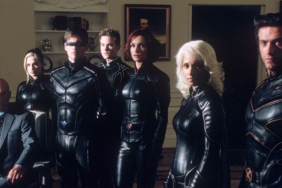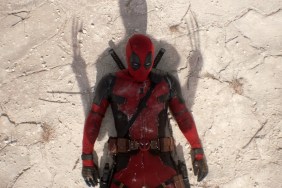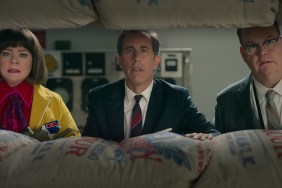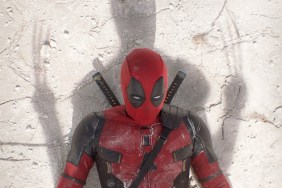Tuesday morning’s DreamWorks presentation ended with a behind-the-scenes sizzle reel for Shawn Levy’s Real Steel, starring Hugh Jackman. Narrated by Levy and Jackman, the clip gave an overview of the story, based on Richard (“I Am Legend”) Matheson’s novel about a dystopian future where people get their entertainment from watching large robots boxing in the ring and introduced roughly a half-dozen robots in the movie who either fight in the official boxing circuit called World Robot Boxing or they fight in underground matches. The undefeatable Zeus has been running rampant over the WRB destroying any robot put against him, something we see in a funny scene of Zeus crushing another robot’s head between his massive fists.
These robots are controlled by humans outside of the ring including Jackman’s Charlie Kenton, a down on his luck boxer forced into retirement when human boxers were made obsolete. The story involves Charlie reconnecting with the son he deserted years earlier and Max (played by Dakota Goyo, who starred in Rod Lurie’s Resurrecting the Champ) helps get Charlie back on the straight and narrow after years of hustling in the underground circuit for money.
The footage included a scene of Jackson arguing with Max and telling him to be careful, but the boy won’t listen until Charlie yells “I mean be careful of that cliff” but it’s too late and the boy slips over the edge and starts sliding down the mud until he reaches the bottom where he finds Atom, the junked out robot that will help bring the two of them together. Atom is different from the other robots because he seems nearly sentient and can mimic and replicate any moves he sees, which is how Charlie trains the robot to fight without needing to be controlled. The behind-the-scenes footage also showed how they used motion capture with real boxers, choreographed by Sugar Ray Leonard, to create lifelike boxing scenes of the robots.
Overall, the footage looked great and a lot brighter than we were expecting considering the source material, which means it probably can appeal to younger kids as well as the teenagers and older males who would generally be attracted to the premise.
ComingSoon.net had a chance to sit down with the energetic Levy and the more laid-back Jackman after the presentation for a brief chat.
ComingSoon.net: So let’s talk about “Real Steel.” It really looked great, especially the robots.
Shawn Levy: You’ve now seen more (than anyone else) – I know your website, so online there’s been a few pieces, but nobody really knows anything.
CS: I know the Richard Matheson story. Was that what got you into doing this or was it just a really good screenplay?
Levy: The longer story short is that Don Murphy, who is my fellow producer, optioned the Matheson story years ago. DreamWorks, Steven really believed in this Mathesonian source material, developed it for years and years and years. They came to me with the screenplay based on it and then together, Hugh and I came aboard. So really, it’s Don Murphy and Steven who nurtured this thing. Then when we came aboard it was a robot boxing movie, but what we wanted to do was actually go back to a slightly more faithful aspect of the Matheson story which is that robot boxing promoter who is so desperate for his shot, so desperate to eek out a living and maybe some redemptive moment, and that’s what we worked very hard to bring into the script once we got involved.

CS: Hugh, you’ve done quite a bit of action in movies over the years, but this is boxing which is a very different thing, and I assume you don’t do a ton of boxing yourself in the movie but did you go through any sort of training for the little moves you do?
Hugh Jackman: I did do some training. I actually did some training with Sugar Ray. I don’t want people to be confused and think I am boxing a lot in this movie. I’m not. If anything, I’m the corner man. I’m the manager, the trainer. I’m the owner or manager of these robots.
Levy: Interestingly when Sugar Ray was working with Hugh, as much as he was coaching Hugh on the physicality, he was telling Angelo Dundee stories. Angelo was Sugar Ray’s corner man, and famously Ali’s corner man. So Hugh was actually listening to the Dundee stories and the mindset of how a corner man communicates with his fighter. Though our fighters are not human, the movie is very much about suggesting that connection anyway between corner and fighter.
CS: On stage earlier, you mentioned that Charlie isn’t a very nice guy, but I wasn’t sure if I got the impression from the footage, so why did you suggest he wasn’t a nice guy or a bad guy?
Jackman: Well, he’s a combination. He’s definitely down on his luck.
Levy: And he resents the hell out of it. He was a boxer and society is not anymore interested in human boxing, so he’s a guy who’s obsolete and he’s bitter.
Jackman: He’s desperate and he’s a little bitter. He’s got a little chip on his shoulder about it all. He owes money to a lot of people, and he’s running as fast as he can and he’s losing the battle. As you see, with his son, you’ll find out later – I’m not sure how much I want to tell at this time…
Levy: Well, but certainly that piece now, I like that the secret’s out. The other thing I hope that this piece communicates is this kid who he abandoned at birth shows up and a lot of the kind of ***hole factor, if you will – and by the way, I use that word with the confidence that Hugh playing an ***hole doesn’t even, is like… Certain actors playing an ***hole, that’s an ***hole, but Hugh Jackman playing an ***hole, still kind of lovable. Hugh as loveable ***hole. He doesn’t want this kid and this kid is dumped on his doorstep. He’s trying to just go day to day and now he’s got a frickin’ 10 year old in his backseat. Really, that’s the turn. It’s not that he gets materialistic, they do start to win, but if anything, that’s when the better Charlie starts to emerge.
Jackman: Really, this is a character that doesn’t believe in himself in the beginning, and he disappoints people ultimately because of that. The movie is a redemptive tale of someone who actually gets a second chance. That can be more frightening sometimes than the first, particularly when you know what’s at stake. I think that’s what really we loved about this story. The son, he just believes in him.
Levy: He believes in him and he believes in this frickin’ robot, this junkyard sparing bot that Hugh’s character’s like, “It’s a piece of sh*t. Sell him off for parts.” The kid is like, “There’s something to this thing.” The movie never confirms nor denies the truth of that, but it flirts with that edge of suggestion.
CS: I’ve got to admit when I first heard about this movie and knowing it was based on Matheson, I thought this was going to be dark and dystopian, but it seems bright and possibly even kid-friendly than I imagined.
Levy: Yeah, I mean, yes and no. Having come from family films, to me, when you say “bright and family-friendly,” I’ve made those movies. This movie is markedly different. I just think it is such a fun concept that to make it kind of dystopian and nihilistic would’ve been to miss an opportunity. Again, in my first meeting with Spielberg I said, “Look, we’ve seen a lot of robot movies.”
CS: Him and Don make them since they also did the “Transformers” movies.
Levy: Right, and yet, my conversation with Don and my conversation with Steven is, “We’ve seen a lot of robot movies, so we’ll never be fresh on that basis alone,” but whether I think we can do something original–because I’ve only seen it in “Iron Giant” and “Wall-E”–is a movie that is about machines, but that is deeply emotional. If we got that right, then we would have something that’s unique.
Jackman: Well said.

CS: I’m curious about the performance capture you used for the fighting and what you and the audiences at the bouts were reacting to? Did you have boxers in the rings doing what the robots would be doing in those scenes?
Jackman: Well, it was a gift for us. First of all, there’s 20 robots, but four of them were built real. I mean, it’s extraordinary, four nine-foot, fully-animated…
Levy: We built the robots and they were real.
Jackman: So when we were this close and I’m operating them, we would have the real robot.
Levy: It would be sitting right here and it changes everything. When you have a robot literally going…
CS: So these were moving robots?
Levy: It’s crazy.
Jackman: You have to explain because you do it better. Explain the…
Levy: The mocap?
Jackman: Yeah.
Levy: I don’t know how techy–but I know your site actually–what “Avatar” created is the page that we kind of took forward, which is it’s motion capture with real boxers, which gave me the advantage of being to direct the creatures’ performances. So I directed the boxers. The boxers are converted into…
CS: Was that done on a separate stage?
Levy: That was six months before we shot, the same place they did “Tintin” and “Avatar,” a place called Giant in Marina del Rey. We did the mocap. We convert them into their robots. We go to Detroit six months later and we use something that actually had not been done on “Avatar,” which is simulcam-B in a live environment. In other words, Jim took the mocap and plugged it into Pandora. Pandora doesn’t exist, so it was mocap in a virtual environment. We went to Detroit in these insane, burnt-out hulks of buildings, and I would line up a shot of Hugh and I would have simulcam, which is simultaneous playback of Hugh and their captured performance I did six months earlier. So when I’m operating the camera, the real camera, I see Hugh and the robot real and live.
Jackman: We’re able to… even in a steadicam shot, it was moving in real time.
Levy: The technology would track the location of the real camera and literally put the co-relative perspective on the robot because when we captured it, it’s from infinite angles, so that’s what we did.
Jackman: So we knew exactly where to look.
Levy: So Hugh would look. I’d be looking on it. Now sometimes Hugh would see a real robot, sometimes he would see a tennis ball, but he would come to the monitor and watch the scene done already with him and the robot, so we could adjust.
Jackman: Right, and I had had a cut version of the fight that I watched and studied. I knew exactly what was going to happen, and I’d remember that, the other hand or right hand or this bit right here. It was so much easier and quicker and for the 10-year-old boy, particularly who…
Levy: There’s no substitute. I mean, there’s no substitute for having built real robots. It changed all the performances in the movie, especially the kids.
You can see what Hugh had to say about the future of The Wolverine with the departure of Darren Aronofsky and the situation in Japan here.
Real Steel opens in regular and IMAX theaters on October 7.









